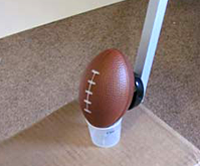Football Science: Distance and Field Goal Kicking—Increasing the Odds of Scoring
Making it to the end zone on a last-second Hail Mary pass is one way to score in football, but when it's 4th and 30, a well-executed field goal for three points can be the game-tipping, winning play. What's the secret to a successful field goal? Students can put the science and math involved in one aspect of field goal kicking to the test with a sports science project that places a rubber-band catapult on the field as the team's football kicker. After seeing how your kicker does at varying distances, you can draw conclusions about when to call the kick team to the field.
Football Science
Have you ever whiled away time with a triangular folded paper football that you and a friend shuffle with your fingertips back and forth, from edge to edge, across a table? When the football crosses the boundary of the edge without falling off the table, you score a touchdown and get to kick a field goal by resting the football on its point and flicking it through the air, across the table, and through the opposing team's finger goal posts.
Paper football is a classic, but perfecting the art of flicking a paper football with your thumb and forefinger won't necessarily translate to a better understanding of field football and how game-winning field goal kicking may depend on a number of scientific variables, including the trajectory of the kick, the way gravity plays upon the ball as it travels through the air, and how far away the kicker is from the goal posts.
Are the odds of making a field goal kick better if the kicker is closer to the end zone or farther away?
This is a great question for students and families to explore with hands-on science!
An Indoor Football Sports Science Experiment
Paper football may not boost your football skills, but a fun hands-on science project might. Combine a rubber band-powered catapult kit with a homemade goal post and a few football-shaped party favors, and you have the makings of an end zone dance-worthy science project!
The new Field Goal! The Science Behind a Perfect Football Kick project from Science Buddies' Sports Science Project Ideas area guides students in an exciting sports science exploration that takes indoor paper football to the next level. Students will have a great time launching mini footballs through the air as they gather data for their science project. Once the official data is collected, it may be game on for students and a group of friends or family members with the catapult and goal setup!
Making Connections
After exploring the relationship between distance and kicking in the Field Goal! The Science Behind a Perfect Football Kick sports science project, you may approach your next game with a completely new perspective on when to kick and when to go for the first down on the ground. Whether you play football or just enjoy watching, math and science can help you narrow in on smart game strategies. Will your favorite team follow a strategy that lines up with the data from your science experiment? Keep track all season long and see how the numbers (and successful kicks) play out!
More Football Science
For more great football science projects, see these Science Buddies Project Ideas:
- Football Field Goals: Going the Distance
- How Far Can You Throw (or Kick) a Ball?
- Sports Science Project Ideas
Catapult Your Way to Better Football Strategy

With the Field Goal! The Science Behind a Perfect Football Kick science project from the Sports Science Project Ideas area at Science Buddies, students can dig into the science of football kicking using an indoor rubber-band powered catapult in the role of kicker.
With the controlled setup, students can kick multiple times from varying distances to find out if distance is related to the percentage of field goals made. This is a great science project for a football enthusiast, but it is also a super science activity for casual home or after-school exploration!
The catapult kit is available for this project.
Categories:
You Might Also Enjoy These Related Posts:
- Plastics and Earth Day - Science Projects
- Arduino Science Projects and Physical Computing
- 10+ Robotics Projects with the BlueBot Kit
- 5 STEM Activities with Marshmallow Peeps
- March Madness Basketball Science Projects: Sports Science Experiments
- Women in STEM! More than 60 Scientists and Engineers for Women's History Month
- Explore Artificial Intelligence and Machine Learning with Student AI Projects
- 10 Reasons to Do the Rubber Band Car Engineering Challenge









